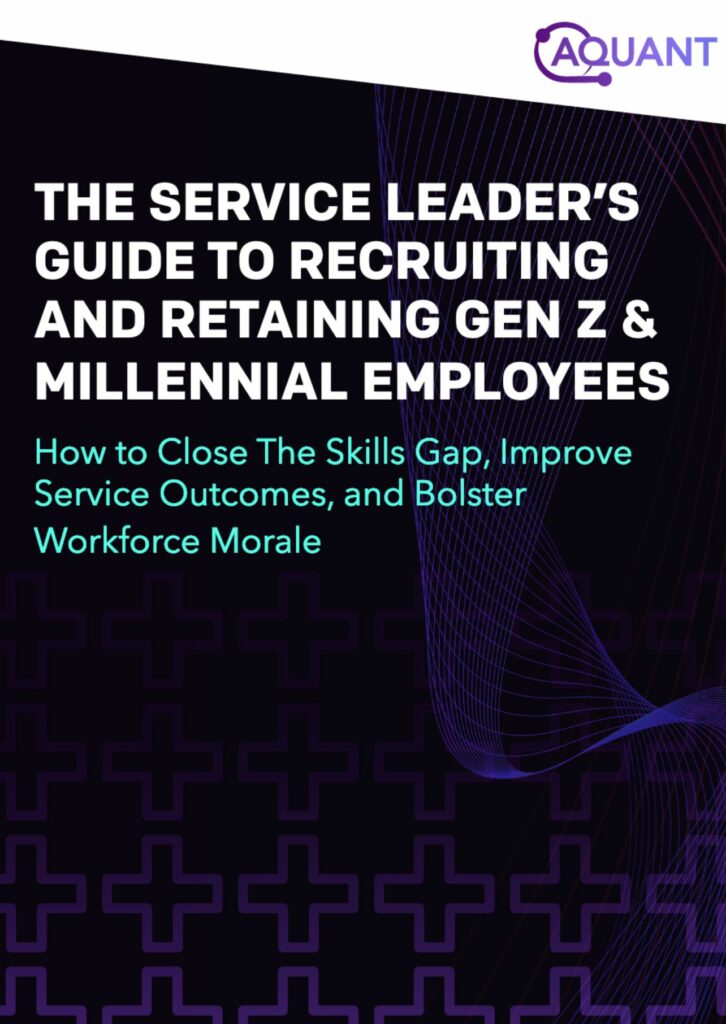Two Major Service Challenges to Overcome
In this second article of a series of excerpts from a recent white paper published by Aquant, we look at two major service challenges to overcome when it comes to the service workforce…
All service organizations face external challenges around evolving customer demands and internal challenges around developing their capacities to address those evolving customer demands. When it comes to the service workforce, two challenges stand out above the rest.
CHALLENGE #1: The Need to Build a New Workforce for Today and Tomorrow
The shifts described above and the disruptive impacts on service delivery, have been hitting the service industry for a decade now, and are projected to continue for at least the next few years. While many organizations have transition plans in place, you should ask yourself:
“Does my transformation consider ALL aspects of the service cycle?”
That includes:
- People
- Processes
- Technology
- Customer demand and shifting preferences
- Long-term scalability
Here’s why the time to act is now.
There is a massive demand for highly skilled talent in the service industry, but it’s in short supply.
A workforce with a wide range of soft and technical skills is required to service today’s mix of equipment and machines. They also need to play the role of front-line brand ambassadors.
More businesses are competing on service as the differentiator vs price. And the quality of service increasingly represents a major competitive advantage.
Top younger and tech-savvy talent have more choices, and they’re more likely to leave a workplace that doesn’t meet their expectations for onboarding, training, professional development, and more.
CHALLENGE #2: Today’s Growing & Costly Skill Gap
Historically (and today too), the service smarts exemplified by industry veterans came primarily from on-the-job experience and were developed over time. A major challenge for service leaders right now is figuring out how to quickly transfer that knowledge from veterans to the new workforce.
Another factor: these experts are being asked to play two major roles at once — leaders want them to be trainers and mentors, but their deep skillset is needed in the field. Your top service experts simply can’t be in two places at once.
We know you’d love to clone your SMEs and have them on your team forever, but that’s not reality. Here’s what’s happening now as a result of the brain drain.
- Increased service costs
- Decrease in service KPIs, including first time fix rates
- More customer churn
- Lower employee morale
Let’s dive deeper into costs, and for this part, we hope you’re sitting down.
The skills gap is expensive. The bottom performing quarter of the service workforce (challengers) costs organizations 80% more than the top quarter of the workforce (service heroes), according to our Service Intelligence Benchmark report.
When you have a failed first service visit, the costs continue to grow. A failed first service visit leads to, on average:
- 2.6 total visits to resolve the service issue
- 15 additional days in Mean Time to Resolution
Customer dissatisfaction and loss of service brand reputation. A failed first visit is especially problematic in light of the pandemic-driven urgency to limit time spent on job sites.
What should service organizations be doing to overcome these issues and build up a dream service team with the know-how to resolve issues efficiently? The first step is attracting, retaining, and empowering members of the two most recent workforce generations, Gen Z and Millennials.
Look out for the next and final excerpt from the white paper “The Service Leader’s Guide to Recruiting and Retaining Gen Z & Millennials Employees” where we look at 4 solutions for effectively building the new service workforce.
Want to read the full paper now? Download the white paper, available exclusively to all FSN PRO members and you can access it instantly.

![]() Data usage note: By accessing this content you consent to the contact details submitted when you registered as a subscriber to fieldservicenews.com to be shared with the listed sponsor of this premium content Aquant who may contact you for legitimate business reasons to discuss the content of this white paper.
Data usage note: By accessing this content you consent to the contact details submitted when you registered as a subscriber to fieldservicenews.com to be shared with the listed sponsor of this premium content Aquant who may contact you for legitimate business reasons to discuss the content of this white paper.


